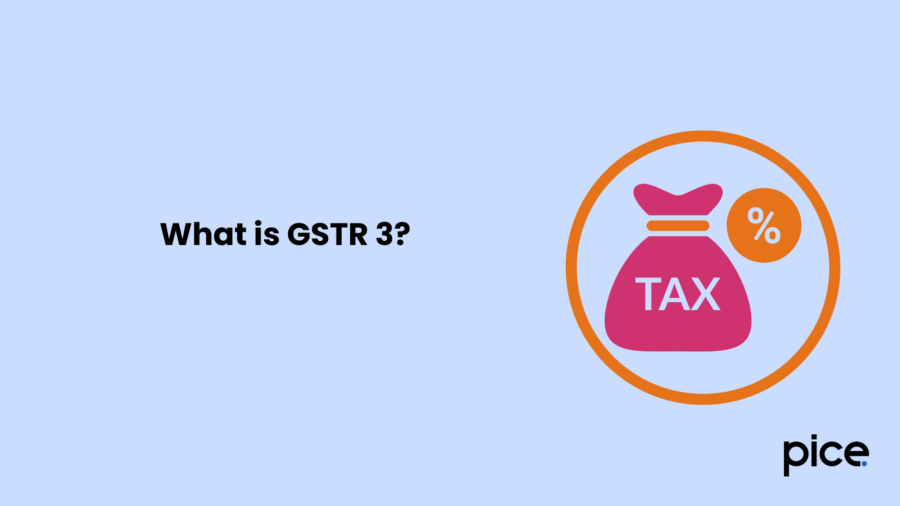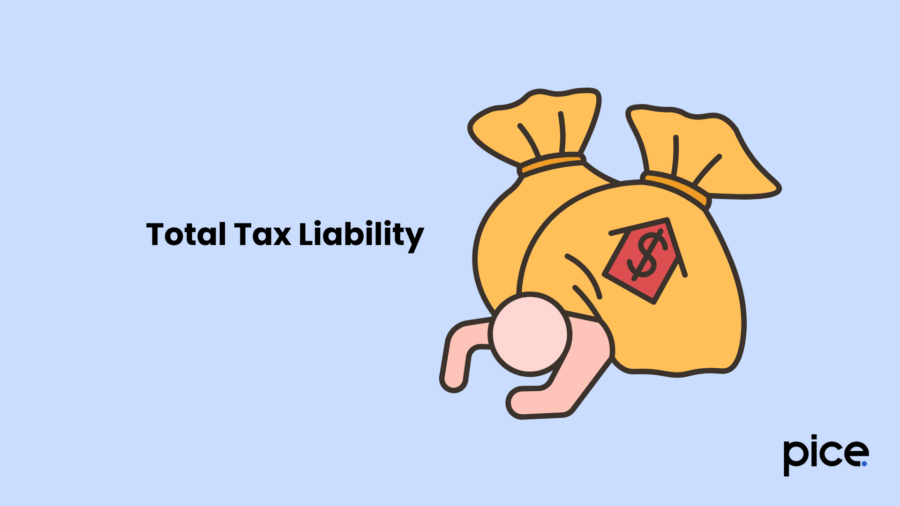GSTR 3 Return: Know its Meaning, Eligibility and Rules
- 18 Mar 25
- 14 mins

GSTR 3 Return: Know its Meaning, Eligibility and Rules
Key Takeaways
- GSTR-3 was a key monthly GST return but is now replaced by GSTR-3B.
- Filing required GSTIN, accurate GSTR-1 & GSTR-2, reconciliation, and tax payment.
- It auto-fetched data from GSTR-1 & GSTR-2, with manual inputs for tax and ITC.
- Mismatches with GSTR-3B required additional tax payments with interest.
- Timely filing ensures compliance, avoids penalties, and maximizes ITC benefits.
The total outward and inward supplies of a taxpayer were covered in a monthly return, also referred to as GSTR-3 under the GST law. On referring to the GSTR-3 return, one could get an idea about complete tax liabilities, input tax credit (ITC) and taxes paid during the said month.
Filing this return was non-negotiable as it was used to aid in the final assessment of a person's tax liabilities. However, its filing has been suspended and GSTR-3B now serves as a provisional declaration of tax liabilities and ITC claims.
Knowing GSTR-3 remains important in case it is reintroduced. In this blog, you can learn the step-by-step process of filing a GSTR-3 return and also get an idea about when to submit this document.
What is GSTR 3?

GSTR-3 is one of the key monthly returns that shows important purchases and sales during a certain month in addition to the total tax liability. It is an auto-populated form that fetches data from the submitted GSTR-1 return and GSTR-2 return.
Accurate and timely filing of GSTR-3 on a monthly basis is mandatory for people who wish to avoid heavy fines and take advantage of the available input tax credit (ITC).
When to File GSTR-3?
Taxpayers must file GSTR-3 by the 20th of a month following a certain tax period. However, taxable persons preferring to submit quarterly returns must file GSTR-3 on the 22nd and 24th of the month following the quarter for which the return is due.
Prerequisites for Filing GSTR-3
Before you are required to file GSTR-3, make sure that you are meeting the following conditions:
- GSTIN: For filing, it is mandatory to have a valid GSTIN. It is a unique identification number with which one can access the official GST portal and file returns.
- Precise GSTR-1 and GSTR-2: Next, the taxable person must ensure that both the GSTR-1 and GSTR-2 are accurately submitted. If you are in doubt, always double-check the transaction details to ensure accuracy.
- Reconciliation: Additionally, it is crucial to reconcile the information of both inward and outward supplies. For this purpose, one can use professional reconciliation tools to tally with their internal records. This strategy can help minimise errors.
- Tax Payment: Lastly, you must confirm that all tax dues are cleared.
All these initiatives are necessary to ensure an uninterrupted filing procedure.
How to File GSTR 3?
One must take care of several steps to execute a successful GSTR-3 return submission. Here's a quick breakdown of the same:
Step 1: Login to Your GST Account
To get started with the filing procedure, you must first access the unified portal with the correct credentials.
Step 2: Proceed to the Returns Portal
Next, you must select the GSTR-3 form by opening the dashboard. Cross-check whether you have picked the right return period before you proceed. It is an essential drill to avoid filing discrepancies.
Step 3: Verify the Auto-Populated Data
Go through the details that have been entered from GSTR-2 and GSTR-1. Make sure that no transactions are misrepresented. For maximum accuracy, consider checking the transactions with your internal records.
Step 4: Provide the Additional Details
You must manually enter some of the details like tax liabilities, ITC claims and payments. While addressing this, you have to include any corrections or adjustments that must be done for the current tax period. Double-checking is compulsory to avoid instances of errors.
Step 5: Reconcile the Data
Check the details to evade problems that can arise later. You can rely on GST experts or use professional reconciliation software to aid this procedure. To maintain direct tax compliance, address any issues that you notice at the earliest.
Step 6: Calculate Liabilities
For the calculation of tax liabilities, use a tool that can determine the final tax amount. Check the figures against your internal records to make sure that they are accurate.
Step 7: Pay Taxes
Clear the dues through the GST portal. For an uninterrupted process, first, ensure that your registered bank account has sufficient balance. Once you have made the payment, keep the acknowledgement receipt handy for future use.
Step 8: Submit and file
After passing all the checkpoints, use your GSTIN to submit the GSTR-3 return. After completing this step, download the receipt for future reference.
Is Filing GSTR-3B Mandatory?
Yes, filing the GSTR-3 return is compulsory for every casual and normal taxpayer who is registered under the GST Act. This rule will be the same even if there aren’t any business transactions during a certain tax period.
Is GSTR-3B a Valid Form?
When taxpayers file the simplified form GSTR-3B, they submit a simplified summary of their GST liabilities and state a valid discharge of the tax burden. In addition to regular taxpayers, those availing the QRMP Scheme also need to upload a duly filled GSTR-3B return. For normal taxpayers, this return needs to be filed monthly while QRMP scheme taxpayers can pay on a quarterly basis.
Format of GSTR-3
As suggested by the Government, there are 15 heads in the detailed form GSTR-3 return. Below, you can grab a quick idea about each of the headings of this detailed form along with their brief descriptions:
- GSTIN
Each GST-registered taxpayer gets a unique GSTIN or the Goods and Services Tax Identification Number. For the time being you do not have a GSTIN, you may also use a provisional ID to file a GSTR-3 return.
- Name of the Taxpayer, Year and Month
Here, one can find the concerned taxpayer’s both legal and trade names. Also, it is essential to check the relevant month and year for which the GSTR-3 return needs to be filed.
Following this segment, there are two distinct parts in GSTR-3.
Among these two, the fields of Part A are auto-populated from GSTR-1, GSTR-1A and GSTR-2. Next, the person filing the valid return has to manually feed in data into Part B.
- Turnover Details
Part A from the previous section features the aggregate or total turnover generated from all types of supply. Further, the total turnover is segmented into:
- Taxable Turnover (excluding zero-rated transactions): Under this head, all the normal sales records are covered. This includes the revenue collected from both registered and unregistered buyers.
- Zero-rated Supply on Payment of Tax: This consolidated turnover comprises export financial transactions on which IGST is paid, and this IGST can later be claimed as a refund.
- Zero-rated Supply Without Tax Payment: Among this category of turnover, one can find export financial transactions that are settled with LUT or bond.
- Deemed Exports: Deemed exports list items that were sold to Special Economic Zones (SEZs). These goods usually do not leave our country.
- Exempted Turnover: Under this, one can find commodities and services that fall outside the purview of GST.
- Non-GST Supply: Again, these are some selected items like electricity, petrol, alcohol for human consumption, etc. that are beyond the scope of GST.
- Nil-Rated Supply: These goods and services attract a 0% GST rate.
- Outward Supplies
All the sales for a relevant month are recorded here. It is an auto-populated section where the information is fetched from already filed GSTR-1.
The header 4 is further divided into:
- 4.1 - Inter-state Supplies (Monthly Net Supply)
It has all the information on interstate sales, including the following data:
- 4.1A. Tax Rate-wise Supplies Excluding Zero-rated Supplies and Reverse Charge Supplies)
This segment shows total sales during a tax period eliminating export supplies and those on which reverse charge is applicable.
- 4.1B. Tax Payable by Recipients of Reverse Charge Applicable Supplies
It is a special category of sales where the buyer needs to pay GST as per reverse charge.
- 4.1C. Zero-rated Supply Made by Paying IGST
Exports for which the seller pays IGST but later reclaims that amount, fall under this category.
- 4.1D. The Value of Online Transactions Made via an E-Commerce Platform Levying TCS (Excluding the Supplies Mentioned under A)
This particularly shows the online sales achieved via e-commerce channels. Here, the person filing the GSTR-3 return can also refer to the GSTIN of the respective operator managing the e-commerce sales.
- 4.2 - Intra-state Supplies (Monthly Net Supply)
Similar to the interstate sale segment, the only difference here is that this segment includes transactions within the supplier's own state.
- 4.3 Tax Effects Because of Amendments Done in Respect of Outward Supplies
All the changes done to the sales invoices appear in this head. If the amounts change, one can notice a change in the ITC as well. These discrepancies often lead to underpayment or overpayment of taxes. Thus, this head assists a businessperson in maintaining an eye on the invoices that undergo changes after a sale.
- Reverse Charge-Attracting Inward Supplies Covering Import of Services (Net of Adjustments Made to Advance Payments)
As mentioned, this head is all about the supplies and purchases made in a particular month. Again, it is a system-generated part that gets its information from form GSTR-2. The head 5 of GSTR-3 return is further divided into:
- 5A. Inward Supplies on Which Tax is Applicable as per Reverse Charge Basis
It comprises your purchases that attracted reverse charge provisions. Under this segment, one can see the details of sales of both interstate and intrastate transactions. The net tax liability from reverse charge includes the net of invoices, adjustments of advances, debit/credit notes, advances already settled, etc.
- 5B. Tax Effect of Changes Associating Actual Transactions That Attract Reverse Charge
This includes the amendments brought to the purchases that draw a reverse charge basis. When the invoice values change, the ITC also alters and it directly impacts the payable tax amount. This heading is vital to prevent such scenarios as it helps keep track of invoices.
- Input Tax Credit
This head summarises ITC applicable on taxable inward supplies which is further segregated into ITC received from ISD and imports, i.e., net of credit or debit notes.
Part I
ITC is displayed separately for inputs such as raw materials for businesses, input services like consulting fees and investments in capital goods like computers and printing machines. Additionally, the ITC collected from the Input Service Distributor (ISD) is shown here. All ITCs are mentioned after taking into account the debit or credit notes.
Part II
Under this part, you can see the changes reflected in the previous month's invoice details and their effects on ITC.
- Adjustment of Sum in Output Tax for Discrepancies and Other Reasons
Any tax for mismatch when tallied against the original returns is listed here. Also, it states the alterations reflected in output liability in the current month. The data is derived from GSTR-2.
Some crucial data included under this head are as follows:
- ITC claimed on duplication of invoices or debit notes
- Outstanding tax on supplies made due to mismatched credit notes
- Reclaiming particulars on rectification of mismatched invoices
- Negative tax liability from previous tax periods
- Reclaim on correction of an incorrect credit note
- Advance tax paid for earlier periods and adjusted in the current period with the due tax on supplies
- Reclaim/reversal of input tax credit (ITC)
- Total Tax Liability

This is the most crucial part of the GST platform as the total output tax liability is calculated here. Further, it is divided into CGST, SGST and IGST.
These tax heads are shown under the following breakups:
- On Outward Supplies: It covers the tax due on regular GST transactions including inter-state sales.
- On Inward Supplies Under Reverse Charge: Applicable taxes on the supplies that draw reverse charges are shown here.
- On Account of ITC Reversal or Reclaim: This is the extra tax you owe or the amount you can get back by reversing or reclaiming ITC. The particulars are retrieved from Table 11 of GSTR-2.
- On Account of a Mismatch Credit Note/Invalid Return/Other Reasons: This covers tax liability because of other mistakes that occurred during the current or earlier tax periods.
- Credit of TDS and TCS
In this segment, you find the details of Tax Deducted at Source (TDS) and Tax Collected at Source (TCS) already paid by the taxpayer. TDS/TCS amounts are subtracted from the total tax liability to calculate the net tax amount.
- Interest Liability
Tax payment delays attract additional interest for the taxpayer. This interest applies at an 18% interest per year. The tax authorities determine the interest tenure from the 20th (the day of filing a GSTR-3 return) to when you clear the dues.
- Late Filing Fee
If someone files their GST returns crossing the deadline then late charges apply along with the interest. This late fee can reach up to ₹5,000, accruing at a rate of ₹100 per day.
- Part B (Needs to be Manually Filled by the Taxpayers)
Here, you see columns where you need to put the right figures. Details to include are the payable tax amount, the tax amount disbursed in cash and the tax amount paid from available ITC.
- Interest, Late Fees and Other Amounts Payable/ Paid (Other than Tax)
One needs to manually put the interest/ penalty amount payable and the amount which has already been furnished. Also, it is essential to mention the figures under the correct heads.
Note that there is no late fee applicable for IGST.
- Refund Claimed Through Electronic Cash Ledger
When the tax collected exceeds the value that is to be met by a taxpayer, they get back the refund.
Under clause 14a, a refund can be claimed when all outstanding return-related amounts for the month have been discharged.
For 14b, each refund claimed will lead to a debit entry in the cash ledger on uploading a genuine GSTR-3 return.
- Debit Records in Electronic Cash/Credit Ledger/Interest Payments
This portion is again auto-generated when a person meets their total tax liability and submits their returns.
In the end, you sign off acknowledging that everything mentioned in the GSTR-3 return form is correct as per knowledge.
Reconciliation Process After GSTR-3B and GSTR-3 Filing
Any discrepancy between the actual liability and the liability declared in GSTR 3B will trigger an automatic update of both GSTR 3 and GSTR 3B upon filing of the GSTR 3 return. In this scenario, if the actual tax amount is more than the sum paid in accordance with GSTR-3B, the concerned taxpayer must pay the extra amount along with additional interest.
Conclusion
A GSTR-3 return was filed by taxpayers to meet the monthly tax liability. The major purpose of this sales document is to maintain business compliance of all the registered entities.
Managing GST compliance at every step can be difficult for some businesses. If you need help with the GST filing procedures or need expert consultancy, you can get in touch with our tax professionals. Taking professional help can make the whole procedure of filing this sales document seamless and streamlined.
💡If you want to streamline your payment and make GST payments via credit or debit card, UPI consider using the PICE App. Explore the PICE App today and take your business to new heights.
FAQs
 By
By 















